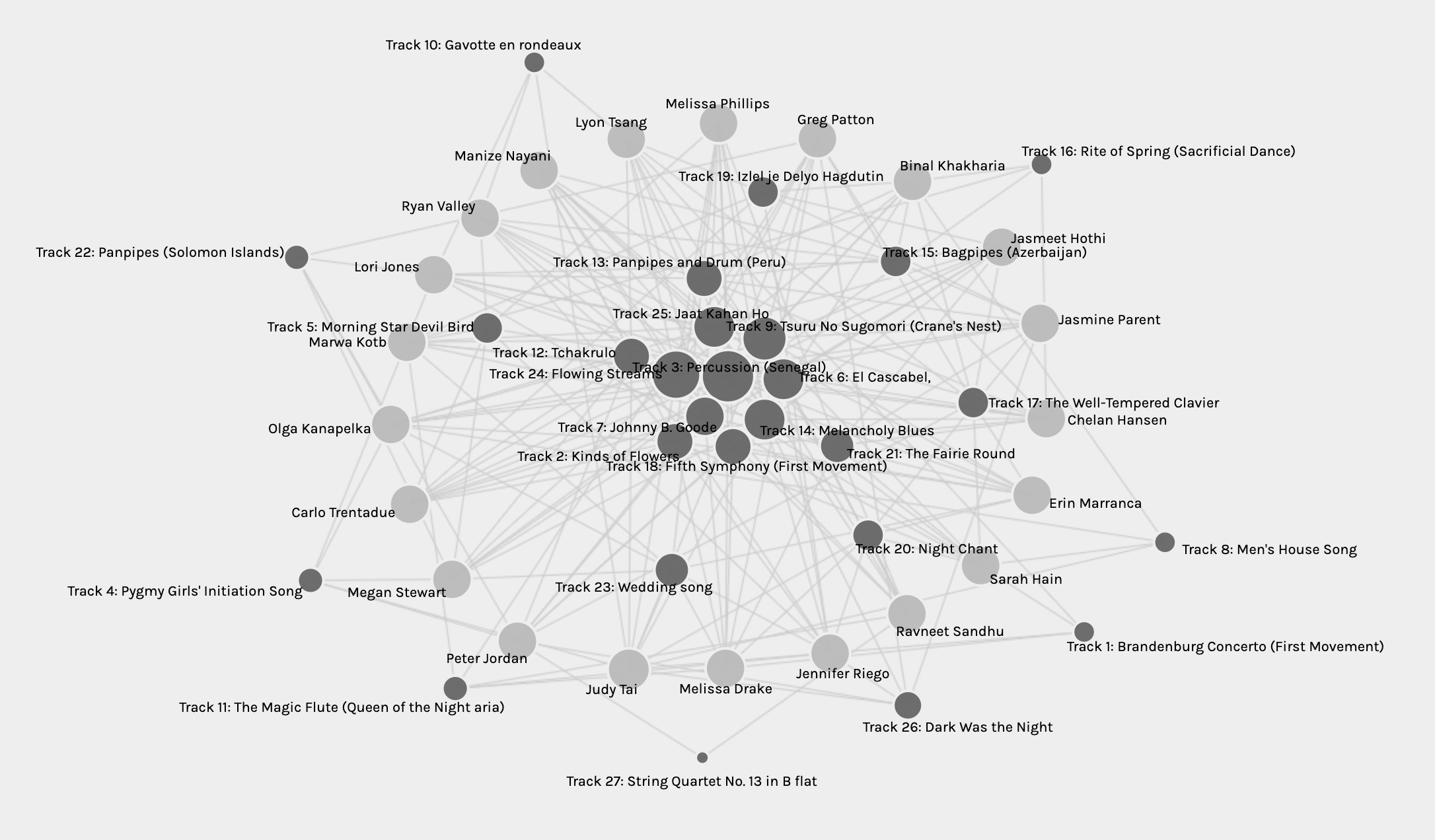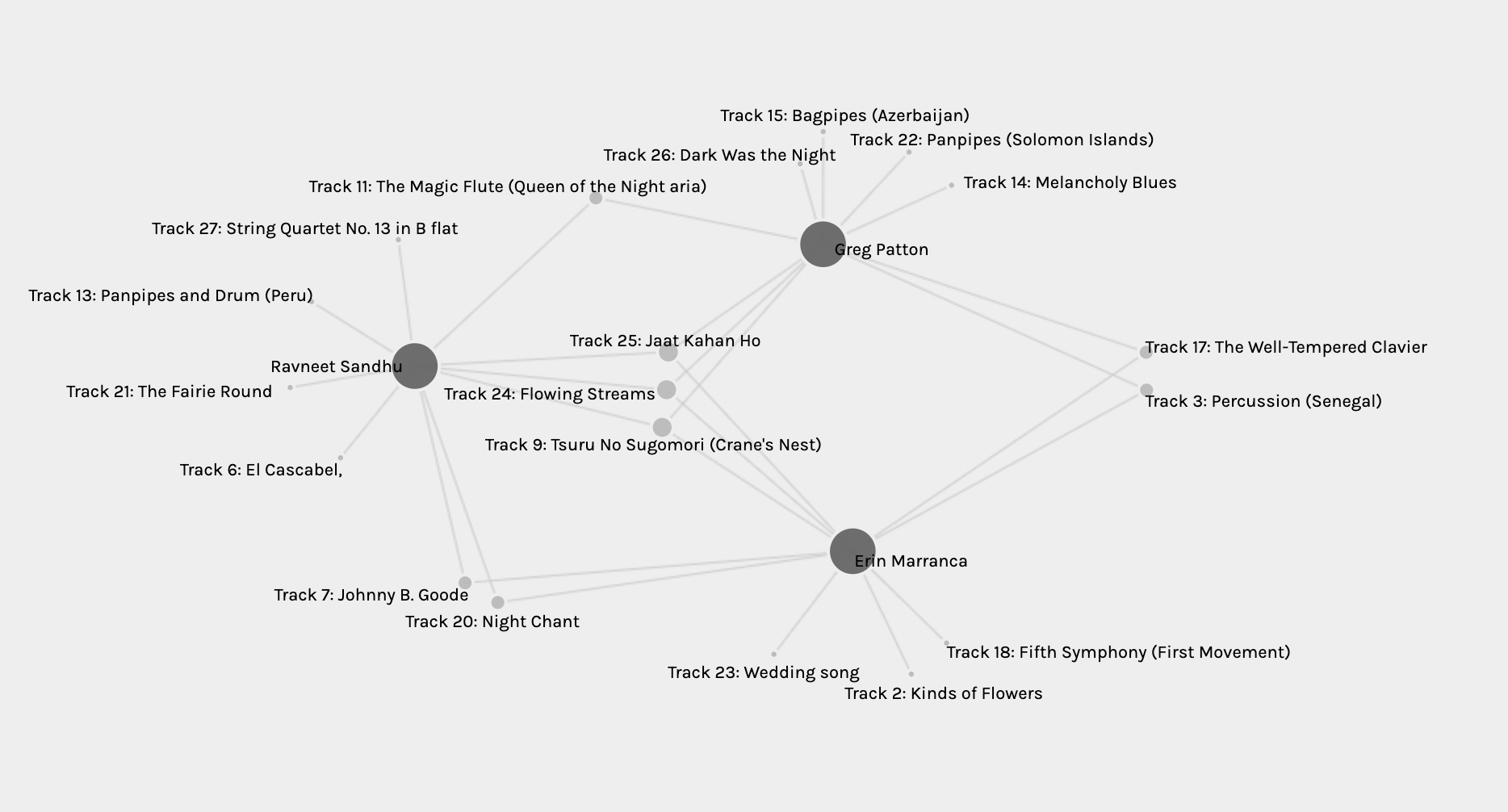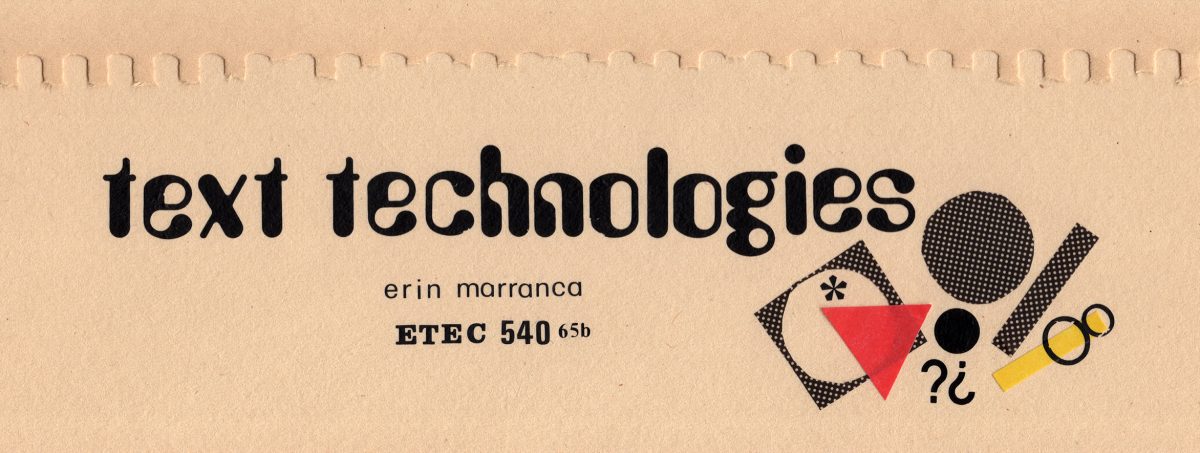Initial Translation of the Visual
The initial presentation of the Palladio graph appeared as a jumble of circles and lines, or “nodes and edges” (Systems Innovation, 2015) too chaotic to extract meaning. I played around with the settings in an endeavour to understand what I was looking at. I changed the size of the nodes and alternated which were highlighted and eventually began to be able to decipher the information. Rather than keep my classmates in clusters, I decided to arrange everyone in a circle, while attempting to moving people with similar song choices closer together on the circle. Then I placed the nodes representing the most popular songs in the middle and radiated them outward based on their popularity. The song nodes outside of the circle of people are those with notably less popularity of which I identified as outliers. Thinking about the less popular songs as outliers had the opposite effect on me and made me curious as to what made them different. I also realized I myself had not chosen any of the outlier songs, which made me feel disappointed, as though these songs held true unique beauty that I failed to recognize and only a select few really understood. Upon revisiting my initial selection criteria, I remembered that my overarching goal was not to identify the strangest or most interesting songs, but to strive for equality by selecting representatives that spanned across the world and I was comforted by the possibility that the graph revealed that I had actually succeeded at this.

Popularity Contest & Looking for Meaning
As I studied the results of the graph, I was surprised to notice that Beethoven’s Fifth Symphony and Chuck Berry’s Johnny B. Goode did not hold the most prominent nodes. The clear winner, and largest grey circle, was the Senegal Percussion track. Don’t get me wrong, the Percussion song is excellent and was one my first quick favourites, but I like simple and layered repetitive beats and regularly listen to music that aligns with this sound – I had not suspected that so many of my fellow classmates did as well. I once took a course in pop music history, and our first lesson started with percussive music from Africa, we discussed the transcendental nature of this type of music and learned about its direct ties to the blues genre in America, followed by jazz, and ultimately rock and roll. When I heard it, I thought, well this track is wonderful, uplifting, and represents historical importance. I wonder if others had these considerations, or whether they were simply picking the songs they liked best, or perhaps were basing their choices on equitable geographical representation – these are all aspects I had considered as well.
But Johnny B. Goode and Beethoven’s Fifth weren’t even in the top five! Last week I had skimmed through my classmates’ blog posts and still can’t stop thinking about something Carlo Trentadue wrote in regards to Beethoven’s Fifth Symphony, “my partner said it was ‘planet earth’s theme song’”(2021). Right!? I am in complete agreement with Carlos’ partner, but clearly the rest of the class did not collectively share the same feeling, at least not as strongly as they fell for Senegal’s Percussion masterpiece.
My curiosity directed me to locate the point where the Senegal Percussion track was revealed in the required listening podcast. I hypothesized that possibly the track won everyone over because it was one of the early songs, and the listeners’ interest tapered as the podcast went on. The Percussion song shows up around the 11-minute mark of a total 36-minute length podcast. It’s difficult to decipher if the song’s placement matters, it is presented in the first half of the podcast, third song on the list – but to contrast this, Bach’s Brandenburg Concerto which came first, had notably low popularity with only four votes. Alternatively, and what may serve to support this theory, the least chosen song with only two votes is Beethoven’s String Quartet No. 13, which is in fact last on the list of 27 songs and therefore last to be played in the podcast.
It should be noted that String Quartet No. 13 is a melancholic piece and frankly, boring. The two classmates who selected it are Ravneet and Peter. I followed up with their blog posts to identify whether either of them communicated any particular reason for selecting String Quartet No. 13. Ravneet does not share any specific information about the song choice but does note a goal of providing equal representation and then choosing songs for their emotional qualities. Most interestingly, Peter chose his songs through a random number system largely removing any subjectivity from his selection process. Would String Quartet No. 13 be more popular if it was the first listed track?
Our Own Modularity Class
I also explored the various modularity classes and sought out the one I belonged to. I found myself linked to Greg and Ravneet Sandhu and re-arranged our grouping’s nodes and edges for clarity and aesthetics. I felt relatively ambivalent about the three songs located in the middle of the graph, the songs that we had all chosen. My main reason for the selection of these tracks was to apply equal geographical representation, so I didn’t feel a great emotional connection to any of the songs. I found that those I connected most strongly with were the ones I shared directly with Greg and Ravneet, but that they didn’t share with each other. I can’t really understand why this is, and perhaps it’s just chance, or perhaps I am trying to apply meaning retroactively – For instance, I did pick Jaat Kahan Ho to represent India, and in that way the selection was systematic rather than emotion-based, but also, I am partial to that mystifying sitar sound.

Reference List:
J, P. (2021, March 7). Golden record. Pj ETEC 540 2021. Retrieved March 16, 2021, from https://blogs.ubc.ca/pjordanetec540/2021/03/07/golden-record/
Sandhu, R. (2021, March 4). Golden record curation. Text Technologies. Retrieved March 16, 2021, from https://blogs.ubc.ca/ravneetsandhu/2021/03/04/golden-record-curation/
Systems Innovation. (2015, April 19). Network Connections. Retrieved from https://youtu.be/2iViaEAytxw
Trentadue, C. (2021, March 4). Task 8 – what can we afford to lose: the golden record. Text, tech & thoughts regarding. Retrieved March 16, 2021, from https://blogs.ubc.ca/etec540techtextthoughts/2021/03/04/task-8-what-can-we-afford-to-lose-the-golden-record/
